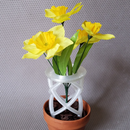Introduction: 3D Printed Face Mask (Light Duty)
COVID-19 has resulted in a shortage of face masks, even basic ones for springtime cleaning (dust), yardwork (pollen), and home repairs (sawdust, drywall dust).
Inspired by a sheet metal air duct part at the hardware store, I designed a 3D printable Face Mask that can use a variety of flat filter materials depending on the needs of the user. Examples of filter materials include t-shirts, vacuum cleaner bags, home air vent filters (used here), and non-woven textiles such as uncoated Tyvek (used in some house wraps and coveralls).
CAUTION: This Face Mask design, especially the air duct filter shown, is not designed to trap viruses and WILL NOT protect you against the coronavirus.
Step 1: Materials and CAD Files
- Filter Material (4"x12" air duct filter used here)
- Straps for securing mask (e.g., rubber band, head band, shoe lace, string)
- Flexible Tubing, 1/4"x3/8" (6x10mm) vinyl tubing used here. Alternatively, weatherstripping or foam tape could be used to create a soft surface against the skin.
- Electrical Tape or Duct Tape
- Ruler, Scissors, Marker
- Computer Files. Attached are the following:
- STL files for 80x120mm (3"x5") and 120x140mm Filter Masks and Lids
- Fusion 360 CAD files for customization
Attachments
Step 2: 3D Print Face Mask and Optional Lid
The Face Mask and Lids were designed to print without the need for rafts or support material. The Face Mask geometry was modeled off of an existing filter mask. Those familiar with Fusion 360 can edit the geometry to customize the shape to their face.
Fusion 360 handles the hard parts:
1. "Loft" creates the transition from the Face Mask to the rectangular filter.
2. "Shell" hollows out the design like a pumpkin.
3. "Cut" opens up the end like the lid of a can.
3D printing is a SLOW process and it will take several hours (even overnight depending on your print resolution) to print both a Face Mask and a Lid, especially if there is not enough room to print both at the same time.
Step 3: Create Cushioning Surface
The T-shaped perimeter serves 2 purposes:
1. It acts as a "brim" and helps hold the part down during 3D printing.
2. It can be used to attach foam, weatherstripping, or in this case, a piece of slit tubing.
Before slitting the tubing, notice any curvature and use it to your advantage. The curvature will help conform to the shape of the face mask. Straighten out the tubing, tape down the ends, and use a ruler to create a straight line. Select a hidden and/or relatively straight portion of the Face Mask and begin to guide the slit tubing around the perimeter. Trim excess tubing and secure the ends with a piece of tape.
NOTE: If you have an old filter mask you could simply cut out the center and use the border as a cushion.
Step 4: Add Filter and Optional Lid
The 80x120mm (3"x5") was designed to use 4"x12" air vent filters available at many hardware store, but as previously noted, many other materials could also be trimmed to size.
After cutting the filter to size (should be slightly larger than the Lid), simply push the Lid down onto the filter and onto the Face Mask. Secure the Lid with a strip of tape around the perimeter.
If a Lid is not used, neatly fold the filter material around the corners of the Face Mask and secure with a strip of tape around the perimeter.
Step 5: Add Straps and Breathe Easier
The rubber bands that I had were not strong enough to support the weight of the face mask. A stronger elastic like a sports headband would work better. Rigid straps could also be used and tied in back like a surgical mask to create a more secure fit.
CAUTION: This Face Mask design, especially the air vent filter, is not designed to trap viruses and WILL NOTprotect you against the coronavirus.

Participated in the
Spring Cleaning Challenge



















